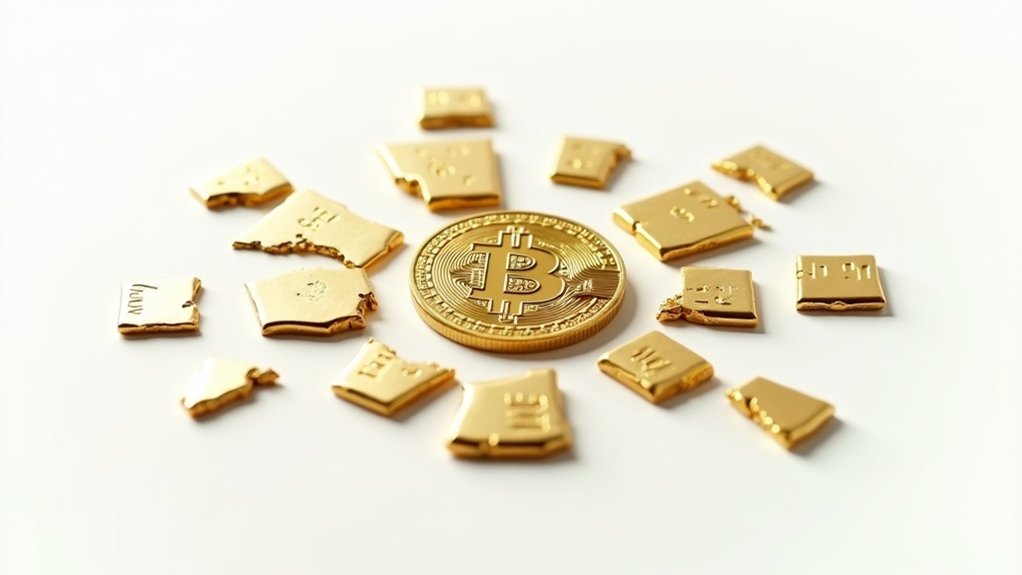Yes, anyone can buy partial bitcoins. No need for whole coins. Fractional Bitcoin, measured in “satoshis” (0.00000001 BTC), makes cryptocurrency accessible regardless of price. Exchanges like CEX.IO let investors purchase with as little as $10 using cards, bank transfers, or even Apple Pay. Fees vary by platform—online exchanges typically beat Bitcoin ATMs. Dollar-cost averaging works well for small, regular purchases. The cryptocurrency world doesn’t discriminate against small wallets.
The crypto world isn’t just for the wealthy anymore. Bitcoin‘s high price tag often scares newcomers away, but here’s the kicker: you don’t need to buy a whole coin. Bitcoin divides into tiny pieces called Satoshis—up to eight decimal places (0.00000001 BTC). That’s serious flexibility for everyday investors. These Satoshi units are named after Bitcoin’s mysterious creator Satoshi Nakamoto.
Cryptocurrency isn’t an exclusive club—even pennies can buy you a slice of Bitcoin’s future.
Most platforms welcome small-timers with open arms. Got ten bucks? That’s enough to start. Cryptocurrency exchanges like CEX.IO, crypto wallets, peer-to-peer platforms, and even Bitcoin ATMs all support fractional purchases. No need to wait until you’ve saved up thousands.
Payment options are plentiful. Debit cards, credit cards, bank transfers, IBAN, Apple Pay, Google Pay—take your pick. Some services even let you buy Bitcoin with cash at retail locations. Convenience isn’t in short supply. Different platforms, different options. Simple as that. Understanding blockchain technology ensures secure transactions across all payment methods.
The fees, though? They’ll bite if you’re not careful. Bitcoin ATMs charge premium rates—sometimes 11% plus a fixed fee. Ouch. Online exchanges typically offer better deals.
Daily limits vary based on your location and verification level. Basic economics: smaller purchases mean fees eat a bigger percentage of your investment.
Security matters. Stick with reputable platforms that verify identity. Your fraction of Bitcoin needs safe storage—hardware wallets for the paranoid, software wallets for the tech-savvy, custodial wallets for the lazy. Peer-to-peer transactions? Proceed with caution.
Many investors use dollar-cost averaging—buying fixed amounts at regular intervals. It’s a smart approach for managing Bitcoin’s wild price swings. Dollar-cost averaging strategy can be easily implemented with as little as $25 weekly purchases. Start small, learn the ropes, expand gradually. Some traders use fractional Bitcoin to diversify their portfolios without breaking the bank.
The bottom line? Fractional Bitcoin makes cryptocurrency accessible to average folks. No need for deep pockets or technical wizardry. The entry barrier is lower than ever. Bitcoin for the masses—not just the classes.
Frequently Asked Questions
What Are the Tax Implications of Buying Fractional Bitcoin?
Fractional Bitcoin gets taxed just like whole coins – it’s property, not currency. Period.
When someone sells it, the IRS wants their cut. Short-term gains (held under a year)? Taxed at regular income rates up to 37%. Long-term? Lower rates of 0%, 15%, or 20%.
Every single transaction needs reporting, no matter how tiny. The IRS isn’t playing around with crypto these days.
Recordkeeping is essential. Miss a transaction and they’ll come knocking.
Can I Transfer Fractional Bitcoin Between Different Cryptocurrency Wallets?
Yes, transferring fractional Bitcoin between wallets is completely possible. No big deal.
Crypto wallets handle those tiny decimal amounts just fine—whether it’s 0.00001 BTC or 0.5 BTC. The process is identical to sending whole coins: copy the receiving address, enter the amount (decimals and all), pay the network fee, and hit send.
Just don’t mess up the address. Network fees apply regardless of the transaction size, so sending dust-sized amounts isn’t always cost-effective.
How Do Transaction Fees Work With Small Bitcoin Purchases?
Transaction fees with small Bitcoin purchases can be brutal.
They don’t scale down with purchase size, meaning a $10 buy might carry the same $2 fee as a $1,000 transaction.
Network congestion drives these costs higher during busy periods. Exchanges tack on their own fees too.
Some platforms even set minimum purchase amounts because of this.
Bottom line? Tiny buys often get hammered by disproportionate fees.
That’s just how the blockchain works.
Are There Minimum Holding Periods for Fractional Bitcoin Investments?
No mandatory holding periods exist for fractional Bitcoin.
Most exchanges let investors buy and sell immediately. Period.
Some practical delays might occur during withdrawal processing—ACH transfers can take up to 5 business days.
That’s just banking reality, not a Bitcoin rule.
Investors create their own strategic holding frameworks (like that fancy 4-Tier model), but these are voluntary choices, not requirements.
The crypto world doesn’t care if you hold for five minutes or five years.
Do All Crypto Exchanges Offer the Same Minimum Purchase Amounts?
No way. Crypto exchanges vary wildly in their minimum purchase requirements.
Some like Gemini and Robinhood have zero minimums – buy as little as you want. Others demand at least $10 (looking at you, Binance) or even more.
Decentralized exchanges technically don’t have minimums, but gas fees make tiny purchases pointless.
Beginner-focused platforms keep it low – $1 to $50 typically.
The difference? Business models, target customers, and regulatory environments. Pretty simple.









